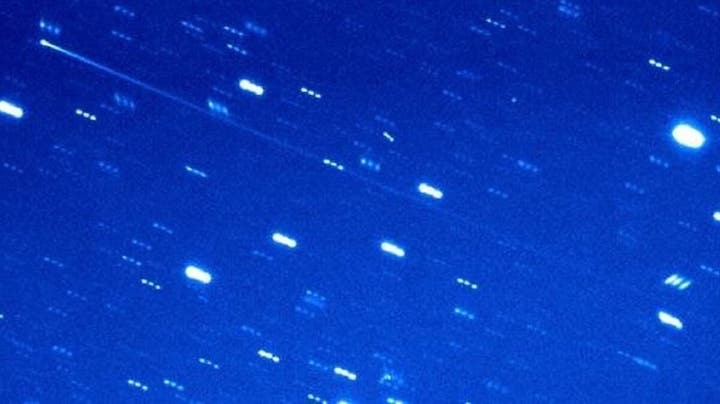12.10.2021
Asteroids that look like comets might teach us more about how water came to Earth.

Composite image of (248370) 2005 QN173 taken with Palomar Observatory’s Hale Telescope in California on July 12, 2021. The head, or nucleus, of the comet is in the upper left corner, with the tail stretching down and to the right, getting progressively fainter farther from the nucleus. Stars in the field of view appear as short dotted lines due to the apparent motion of Solar System objects against background stars and the process of adding together multiple images to increase the visibility of the tail. Credit: Henry H. Hsieh (PSI), Jana Pittichová (NASA/JPL-Caltech).
The distinction between asteroids and comets used to be clear-cut.
Comets were icy bodies that spent most of their time in the cold, dark, outer reaches of the Solar System but occasionally plunged toward the Sun on kamikaze dives that warmed them, vaporised their ices, and produced the dramatic tails we know and love. Asteroids were basically rocks that circled sedately in orbits more like that of Mars.
It’s a pretty picture. But it’s also wrong.
A few years ago, astronomers were stunned to discover that some asteroids behave like comets.
A great example is an asteroid called (248370) 2005 QN173. It’s been known since 2005, but in July 2021, Henry Hsieh of the Planetary Science Institute in Arizona, US, told a virtual meeting of the American Astronomical Society’s Division for Planetary Sciences that astronomers had spotted on it a pencil-thin tail 720,000 kilometres long, but only 1,400km wide.
“[That’s] equivalent to seven inches [about 18 centimetres] wide, scaled to the length of a football field,” Hsieh said. “[QN173] can be thought of as both an asteroid and a comet.”
A number of things could be causing this, including debris thrown off by a recent impact from another asteroid. But a search through millions of older images that might have captured QN173 found one from July 2016 that also shows the tail, says Colin Chandler, a doctoral student at Northern Arizona University. Dust thrown off by a collision wouldn’t have lingered like that for five years.
More likely, he and Hsieh say, the tail is produced by a water-rich layer of material, now exposed to sunlight and slowly vaporising into space.
Comet-asteroids like QN173 are exciting in part because they provide clues as to how the Earth got its water.
Not long ago, it was presumed this happened when the infant Earth was peppered by comet impacts. Now, it looks increasingly like asteroids like QN173 might also have played a role. Finding such asteroids is also important for space exploration, because they might be convenient locations for spaceships and space stations to get water, without having to cart it all the way from Earth.
Meanwhile the hunt is on to find more of them. “Fewer than 30 of these have ever been found,” Chandler says. “If you want to study them with any degree of confidence, you have to find more.”
To do that, he is recruiting citizen scientists to pore through millions of images looking for more. Already, a woman in Switzerland has found one.
If you want to help, just log onto the Active Asteroids project, take a brief training tutorial, and sharpen your eyes. Chandler admits it’s like looking for needles in haystacks. But with enough searchers, such needles can be found.
Quelle: COSMOS
